Washington, D.C., USA - October 16, 2013 - General Motors Chairman and CEO Dan Akerson addressed the Securing America's Energy Future summit Wednesday on the 40th anniversary of the 1973 Arab Oil Embargo. His prepared remarks follow. As always, the speaker's words are definitive.
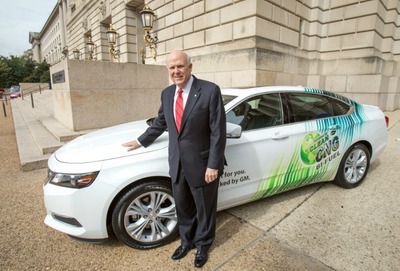 |
General Motors Chairman and CEO Dan Akerson unveils the 2015 Chevrolet CNG-Capable, Bi-Fuel Impala Wednesday, October 16, 2013 in Washington, DC., USA.
The full-size sedan can run on both cleaner-burning, mostly domestically produced compressed natural gas (CNG) or gasoline.
A separate CNG fuel tank, mounted in the trunk, enables the driver to switch between fuels at the push of a button.
CNG is less costly and significantly reduces carbon dioxide emissions.
Photo courtesy GM / Chevrolet / Mark Finkenstaedt |
| |
Washington, D.C., USA – October 16, 2013
General Motors Chairman and CEO Dan Akerson addressed the Securing America’s Energy Future summit Wednesday on the 40th anniversary of the 1973 Arab Oil Embargo.
His prepared remarks follow.
As always, the speaker’s words are definitive.
# # #
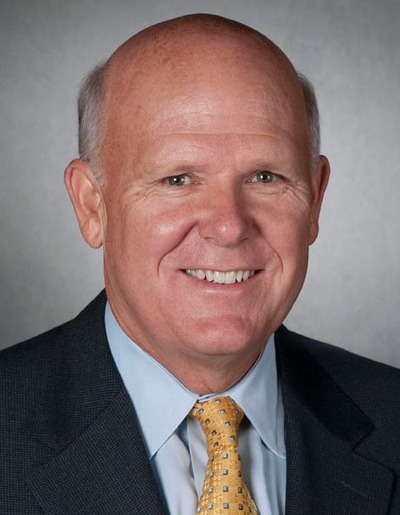 |
Dan Akerson at General Motors headquarters in Detroit, Michigan, USA.
Photo courtesy GM / Steve Fecht |
| |
Good afternoon and thank you for that kind introduction.
On behalf of the General Motors team, I would like to thank Fred Smith and SAFE for inviting me to participate in this vital conversation.
You do important work for which we are all grateful... but I can’t wait until the day that this organization goes out of business.
That would mean we have taken advantage of our nation’s many gifts, and finally achieved energy independence.
The good news is that day is closer than ever.
You know, OPEC was founded in 1960. And like most of us… it didn’t start causing trouble until its teen years.
In 1973, OPEC pulled the IV (eye-vee) drip on our petroleum habit and we went into shock.
It was an easy thing to pull off.
Gasoline was cheap at 38.5 cents per gallon or about $1.96 in today’s money.
The average new car only got about 11.9 miles per gallon – a huge step backward from 1923 when cars averaged 14 mpg.
And our early efforts to develop mileage champs produced rides that only a Shriner could love.
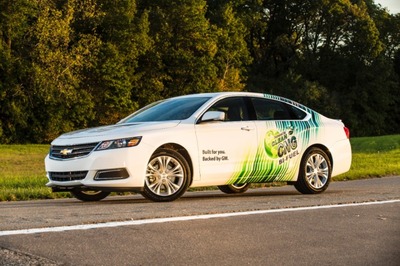 |
2015 bi-fuel CNG Chevrolet Impala.
The 2015 Chevrolet Impala bi-fuel sedan, expected to go on sale next summer, is the only original equipment manufacturer-produced full-size sedan in North America capable of running on either cleaner-burning, mostly domestically produced compressed natural gas (CNG) or gasoline.
Photo courtesy GM |
| |
Here’s what we sent to the EPA’s first-ever Symposium on Low Pollution Power Systems.
It’s just amazing what you can find in the National Archives.
Here is a remarkable coincidence.
At the same time that officials were circling a Michigan parking lot in rudimentary hybrids, OPEC ministers were issuing a communique announcing the oil embargo.
From today’s vantage point, we can laugh about the cars...
We can laugh about the haircuts – almost everyone in those pictures except for Congressman Dingell has gone from “long hair” to “longing for hair.”
But we have some serious decisions to make to put all of that in the rear view mirror for good.
As an engineer by training, I try to be pragmatic.
And the practical solution is to follow the confluence of two powerful forces that can overcome just about any challenge… including energy security.
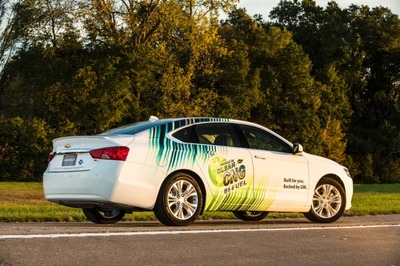 |
2015 bi-fuel CNG Chevrolet Impala.
The 2015 Chevrolet Impala bi-fuel sedan, expected to go on sale next summer, is the only original equipment manufacturer-produced full-size sedan in North America capable of running on either cleaner-burning, mostly domestically produced compressed natural gas (CNG) or gasoline.
Photo courtesy GM |
| |
First is the desire to pass along something good to the generations that follow us.
My wife and I raised three children.
Now we have three grandchildren and we want them to inherit a better world than we did.
When we were just getting started, my wife and I rented our home.
We promised our landlord to leave the house in better shape than we found it.
You know what? At the end of the day, we are all renters on this earth.
No one wants to give their children anything less than what they enjoyed.
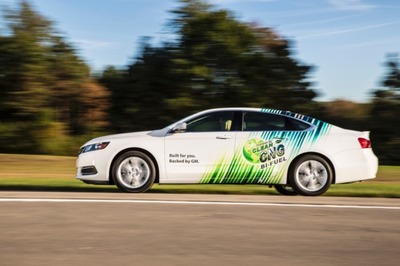 |
2015 bi-fuel CNG Chevrolet Impala.
The 2015 Chevrolet Impala bi-fuel sedan, expected to go on sale next summer, is the only original equipment manufacturer-produced full-size sedan in North America capable of running on either cleaner-burning, mostly domestically produced compressed natural gas (CNG) or gasoline.
Photo courtesy GM |
| |
We want the best for them, and that includes our environment.
This self-interest extends to business, too.
Smart companies increasingly recognize the benefits of secure, affordable and sustainable energy.
The second force is the power of the market to drive lasting change.
Consumer demand, coupled with innovative, affordable technology always moves the needle.
Energy security is a great example. We have learned a lot in 40 years.
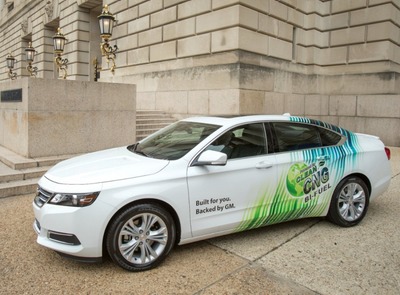 |
Chevrolet Introduces CNG-Capable Bi-Fuel Impala.
The 2015 Chevrolet CNG-Capable, Bi-Fuel Impala is unveiled Wednesday, October 16, 2013 in Washington, DC, USA.
The full-size sedan can run on both cleaner-burning, mostly domestically produced compressed natural gas (CNG) or gasoline.
A separate CNG fuel tank, mounted in the trunk, enables the driver to switch between fuels at the push of a button.
CNG is less costly and significantly reduces carbon dioxide emissions.
Photo courtesy GM / Chevrolet / Mark Finkenstaedt |
| |
From the Nixon era to today, successive administrations pursued energy security by calling on science and industry to innovate on a political timetable.
Remember coal gasification, fast-breeder nuclear reactors and cellulosic ethanol?
They were all cut from the same bolt of cloth: promising technologies... but not profitable... and therefore not ready for prime time.
Now we know that U.S. energy security won’t come from a one-off moonshot.
It will flow from our systematic investment in technology and innovation...
Our drive to get more from existing energy sources and renewables...
Our commitment to conservation...
And it will be assured by fully and safely exploiting our shale gas reserves.
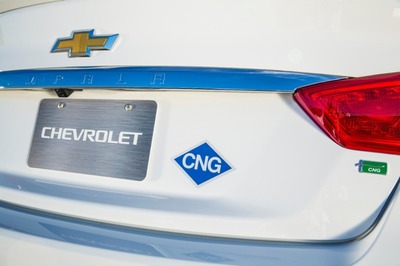 |
2015 bi-fuel CNG Chevrolet Impala.
The 2015 Chevrolet Impala bi-fuel sedan, expected to go on sale next summer, is the only original equipment manufacturer-produced full-size sedan in North America capable of running on either cleaner-burning, mostly domestically produced compressed natural gas (CNG) or gasoline.
Photo courtesy GM |
| |
I personally believe that all of these elements must be enshrined in a national, market-based. consumer-focused energy policy that has straightforward goals:
Affordable energy with certainty of availability... cleaner air and water... lower CO2 emissions... a significantly lower trade deficit... and balanced budgets.
GM’s own experience shows that efficiency, conservation and innovation are achievable, good business – and highly valued by consumers.
By saving energy and increasing use of renewable energy sources, our global facilities achieved a 28 percent reduction in CO2 emissions on a per-vehicle-produced basis between 2005 and 2010… and we are on the way to achieving an incremental 20 percent reduction by 2020.
Along the way, we have become a leader in reuse and recycling.
In fact, our reuse and recycling program generates about $1 billion in revenue a year.
For context, that is more than three times Twitter’s annual ad sales.
The tip of the spear, however, is the GM fleet.
We have an aggressive – and progressively “greener” – product plan for the United States.
Over their service lives, our 2011 through 2017 model year vehicles alone will reduce our national fuel consumption by about 12 billion gallons.
This will offset almost a full year of crude oil imports from the Persian Gulf.
These are huge improvements and the technology mix we are using might surprise you.
Clean diesel and electrified powertrains are all part of the plan because they deliver stunning performance.
For example, a husband and wife team recently drove a new Chevrolet Cruze diesel 3,700 miles across Canada and averaged nearly 55 mpg...
Our new Chevrolet Spark Electric Vehicle can accelerate 0 to 60 miles per hour as quickly as the iconic ’67 Camaro SS...
And it’s possible to drive 1,000 miles or more between fill-ups in a Chevrolet Volt or the all-new Cadillac ELR, if you do most of your driving in pure electric mode.
I bought one of the first Volts for my family, and our gas bills have been de minimus.
Over 10,000 miles, we have only spent about $75 on gasoline.
We take mostly short trips. But I like knowing that I can drive a Volt from Detroit to Palo Alto without having to play the EV-version of connect the dots.
A cross-country drive is no problem because we engineered a creative solution to range anxiety – the biggest obstacle to owning an electric vehicle.
If you’re 20 miles from home when the Volt’s battery runs down, you just keep driving because the car’s gas engine serves as an onboard electric generator.
Innovations like this are why the Volt has won more awards than any car we’ve made… and we are proud to add SAFE’s Advanced Technology Energy Security Prize to the list.
Despite our success with advanced technology vehicles, however, the fuel of choice across our near-term planning horizon is still going to be gasoline.
That’s because we’re making so much progress in aerodynamics, thermodynamics, powertrain control strategies and weight reduction.
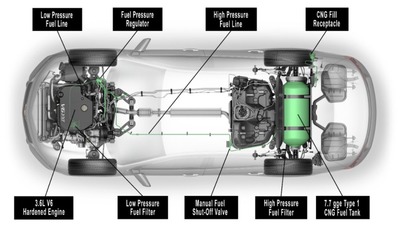 |
2015 bi-fuel CNG Chevrolet Impala.
An overlay of the CNG system shows key components including the engine and gaseous fuel storage fuel storage and delivery system, which was developed and validated by GM engineers, and backed by GM new vehicle and powertrain limited warranties.
Photo courtesy GM |
| |
These “efficient fundamentals” are being complemented by advanced transmissions, turbocharging, “stop-start” technology and other features.
Together, they will help consumers go farther on a gallon of fuel and save money at the pump. They will save GM money too.
Without them, we would be spending up to $3 billion more on high-cost or unprofitable technologies to meet ever-more stringent state and federal environmental regulations.
Natural gas powertrains are one of the areas where we have increased investment because we believe the technology can satisfy the “green” needs of both the environment and stockholders.
I think T. Boone Pickens is spot on when he says that using more natural gas can transform our economy and raise our standard of living.
Hypothetically, if the nation’s entire heavy truck fleet switched from diesel to natural gas, we could reduce oil imports by about a third and sharply cut the fuel component of shipping costs.
Natural gas makes business sense in smaller trucks for the same reasons.
That’s why GM has introduced a range of vans and pickups that use CNG.
Now we are going to open up a new front.
I am proud to announce today that Chevrolet is going to launch America’s best car... powered by America’s fuel.
Next summer, we will offer the groundbreaking Chevrolet Impala with an engine that can switch seamlessly from CNG to gasoline.
There will be nothing like it on the road – literally.
Consumer Reports called the Impala the best sedan you can buy... and none of our competitors offers a bi-fuel passenger car.
In addition, the Impala will carry a factory warranty on the entire powertrain and fuel system... just like our other CNG vehicles.
That can’t be said about the vast majority of natural gas vehicles.
As compelling as the Impala story is, let me be clear about one thing up front: our volumes will be small, at least initially.
Most of our customers are going to be commercial and government fleets, and selling 750 to 1,000 units in the first model year would be a home run.
Why?
Despite hundreds of millions of dollars of private-sector investment, CNG stations are far from ubiquitous.
Today, there are about 1,200 nationwide and only about half are open to the public. This compares with more than 168,000 retail gasoline stations.
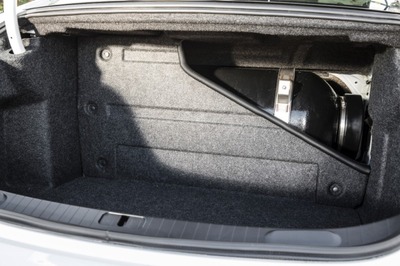 |
2015 bi-fuel CNG Chevrolet Impala.
While EPA estimates on the 2015 bi-fuel Chevrolet Impala are not yet finalized, an approximately eight gasoline-gallon-equivalent CNG tank mounted in the Impala’s trunk is expected to provide up to 150 miles of vehicle range for a total range of up to 500 miles.
Photo courtesy GM |
| |
Companies like Waste Management are doing something about this issue.
Still, more needs to be done.
To give the CNG infrastructure time to play catch up, we got creative and engineered two energy reservoirs for the Impala, just as we did for the Volt.
This approach takes range anxiety completely off the table by offering 150 miles of range using CNG and an additional 350 miles on gasoline.
Of course, range anxiety isn’t the only barrier we have to overcome.
Others include the incremental cost and packaging issues associated with CNG fuel systems.
We have teams working on these challenges, and they are squarely focused on commercializing their research.
I’m confident they’ll get the job done because once again, the Volt shows the way.
For example, our engineers reduced the cost of the Volt’s powertrain so we passed the savings on to consumers.
We’re also applying “lessons learned” from the Volt to design more affordable EVs with even more range.
GM will continue to innovate on all fronts. But there is a growing list of things that the government needs to address so the nation can realize the full benefits of its natural gas reserves.
These include our export policy... pipeline capacity... a refueling infrastructure strategy... and clear, sensible standards for fracking.
We also need to rationalize the country’s alternative fuel laws and incentives.
Finding the best solutions is going to require government, industry, environmental and labor groups to work together.
The question is: Are we willing? I think the signs are good.
Everywhere I look, I see people who are ready to advance the national interest. For example, the Environmental Defense Fund is working with more than 90 partner universities and natural gas industry companies to study CO2 emissions from fracking...
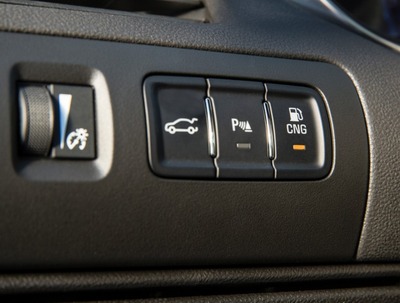 |
2015 bi-fuel CNG Chevrolet Impala.
A separate CNG fuel tank, mounted in the trunk, enables the driver to switch between fuels at the push of a button when driving the 2015 bi-fuel CNG Impala.
When the CNG tank is depleted, the system automatically switches to gasoline.
Photo courtesy GM |
| |
Chevron and Shell have joined gas producers and groups including the Environmental Defense Fund to form an independent center that will set standards for fracking in Appalachia...
And more than 20 states led by Colorado and Oklahoma have pledged to expand government fleet purchases of natural gas vehicles.
For GM’s part, our relationships with CARB, NHTSA, the EPA and environmental groups, including the Blue-Green Alliance, are far more constructive than ever before.
So there. I have asked and answered my own question. Can we do it? We are doing it.
It is now time for the Administration and Congress to seize this unique moment in history by facilitating and even expanding the dialogue already underway.
This is our first, best and perhaps only chance to create a new consumer-driven national energy policy from a position of strength and abundance.
We can do it.
We must do it.
So I will close by recommitting GM to do our part... and more... to make it happen.
Thank you very much.
About General Motors Co.
General Motors Co. (NYSE:GM, TSX: GMM) and its partners produce vehicles in 30 countries, and the company has leadership positions in the world's largest and fastest-growing automotive markets.
GM, its subsidiaries and joint venture entities sell vehicles under the Chevrolet, Cadillac, Baojun, Buick, GMC, Holden, Isuzu, Jiefang, Opel, Vauxhall and Wuling brands.
More information on the company and its subsidiaries, including OnStar, a global leader in vehicle safety, security and information services, can be found at http://www.gm.com
Source: General Motors
http://media.gm.com/content/media/us/en/gm/news.html
ASTROMAN Magazine - 2013.10.03
Mall Gets First Public SAE Fast-Charging Station for EVs
http://www.astroman.com.pl/index.php?mod=magazine&a=read&id=1563
ASTROMAN Magazine - 2013.08.10
2014 Chevrolet Volt Now Offers Even Greater Value
http://www.astroman.com.pl/index.php?mod=magazine&a=read&id=1512
ASTROMAN Magazine - 2013.02.04
General Motors Pledges to Promote Workplace Electric Vehicle Charging. Joins Google, Verizon and others to meet DOE challenge
http://www.astroman.com.pl/index.php?mod=magazine&a=read&id=1404
ASTROMAN Magazine - 2013.01.13
Chevrolet Next-Gen MyLink Wins CNET Best-of-CES Award
http://www.astroman.com.pl/index.php?mod=magazine&a=read&id=1386
ASTROMAN Magazine - 2012.10.07
General Motors: How Much is Your Charge Charging You?
http://www.astroman.com.pl/index.php?mod=magazine&a=read&id=1329
ASTROMAN Magazine - 2012.03.06
Ampera and Volt voted European 'Car of the Year 2012'
http://www.astroman.com.pl/index.php?mod=magazine&a=read&id=1196
ASTROMAN Magazine - 2012.02.25
2012 Chevrolet Volt Cleared for California's Carpool Lanes
http://www.astroman.com.pl/index.php?mod=magazine&a=read&id=1187
ASTROMAN Magazine - 2012.01.07
GM Announces Enhancements to Chevrolet Volt
http://www.astroman.com.pl/index.php?mod=magazine&a=read&id=1145
ASTROMAN Magazine - 2011.04.15
Remarks by Dan Akerson to the Society of Automotive Engineers 2011 World Congress
http://www.astroman.com.pl/index.php?mod=magazine&a=read&id=941
ASTROMAN magazine
|

